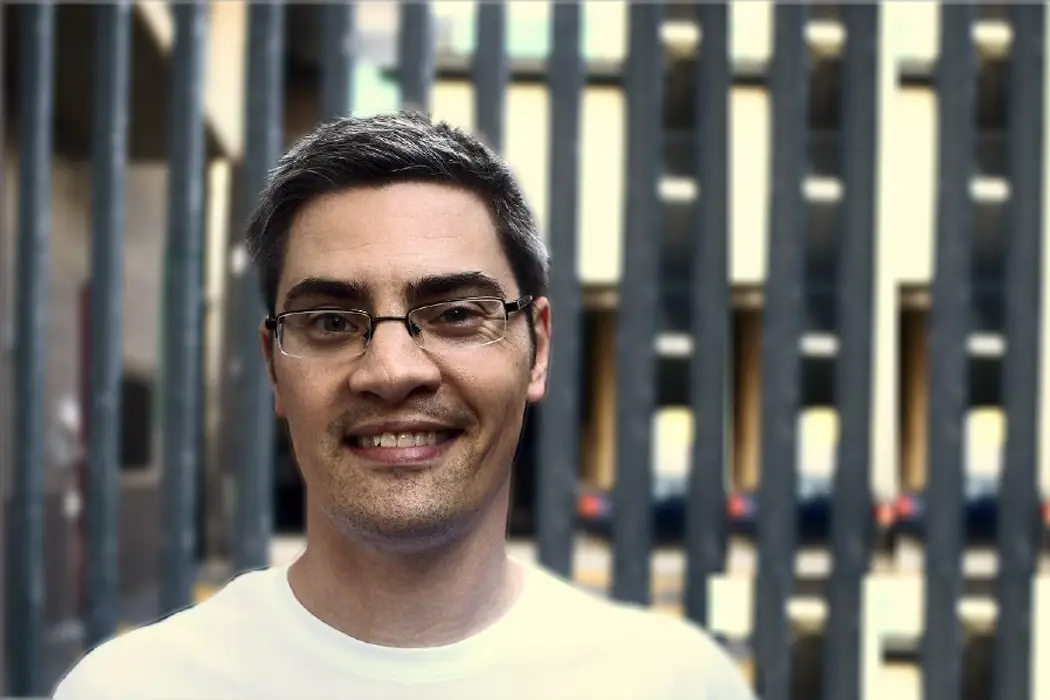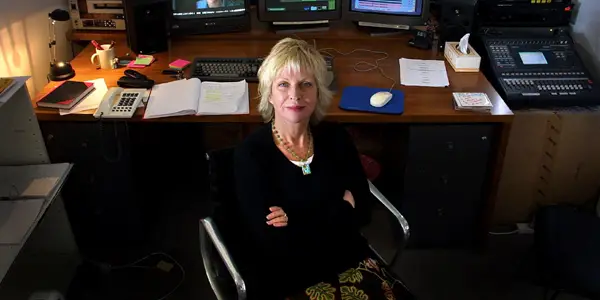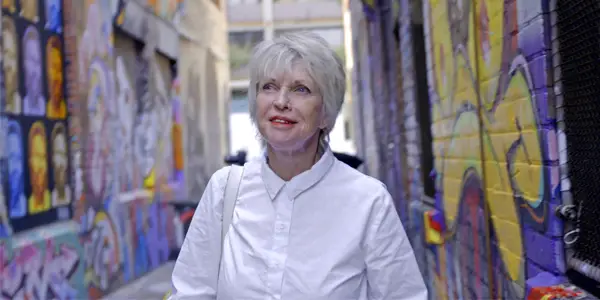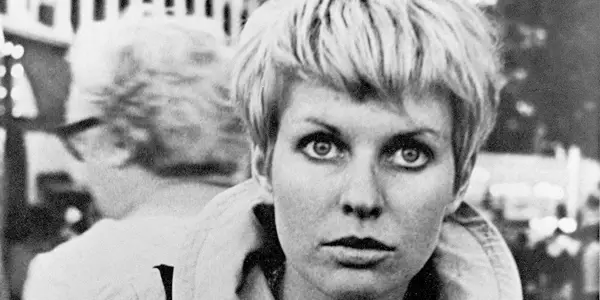Talking Editing With Axel Grigor, Director Of JILL BILCOCK: DANCING THE INVISIBLE

Alex is a 28 year-old West Australian who has a…
Despite the increased awareness and participation of filmmaking and the complex process behind the creation of feature films, the art of editing is one that continues to be quite underrated and misinterpreted by general audiences. Much like great cinematography, most of the time, the greatest editing is simply something you don’t notice, it gives the film structure, turning hours of footage and other assorted elements into a complete package.
In his new documentary, director and editor Axel Grigor has chosen to put the spotlight on one of Australia’s most celebrated editors, Jill Bilc*ck. In Jill Bilc*ck: Dancing the Invisible, Grigor fuses the incredible journey of the influential editor, from her beginnings at the ABC, to her diverse work on many of Australia’s beloved films, such as Strictly Ballroom, Muriel’s Wedding and Red Dog. In preparation for its Australian premiere at the Adelaide Film Festival, I got to chat with Axel about his new film, the importance of film editing and the people who conduct it.
Alex Lines for Film Inquiry: As someone who is quite passionate about the art of film editing, do you feel, despite it being an incredibly vital part of the filmmaking process, that it’s something that’s frequently overlooked?
Axel Grigor: Oh absolutely it is, I still think it’s very hard to discuss and disseminate what a film editor does or has done on a film, so I think telling Jill’s story and having more conversations about what editing involves and what role we have in a film is essential. Cinema has been going on for over a hundred years and there’s still little general knowledge about what editing is and what you do.
The example I always use is that people will always praise The Wild Bunch for its editing, and state that they love how Peckinpah edited it, but always leaving out that it was actually Lou Lombardo who cut that picture.
Axel Grigor: Yeah, you never hear the name of the editor who did The Wild Bunch or even connect that to earlier experiments in film editing, like what the Russians did in the 1920’s or the Germans, editing is what turned cinema into an art form, before that it was just film rolling a camera until it stopped. But when we start putting images together and start making montages, creating more powerful ideas by adding two shots together, creating a higher meaning, that’s when film becomes film-making.
What was the inception of this project? Did you know Jill before making the movie?
Axel Grigor: No, I met her in 2012 in Brisbane. I used to run the Australian Screen Editor’s Guild chapter in Queensland, and a film school had an international editing talk and they invited a lot of great editors from around the world, but we didn’t have one from Australia, so I reached out to Jill to see if she had time to come and she did for three days and that’s when I got to really know and I found her really fascinating.

When would you say that were you first aware of Jill’s work?
Axel Grigor: This is going back to my teens, I’m from Sweden, I moved to Australia in 1999, to study. But before then, as a teenager in Sweden I had seen Strictly Ballroom, Muriel’s Wedding and Romeo and Juliet was just coming out as awaiting to study film, and these films had a deep impact on me as a young aspiring filmmaker. So it didn’t take too long to connect that there was one woman that had her hand in all of these films, and I became very curious about what Jill Bilc*ck had done to these films to make them so special, so the name meant a lot to me, but I had no idea who she was, so that curiosity always stayed with me till I had that chance to invite her.
Documentaries can be some of the most brutal projects in terms of shooting times and the amount of editing needed, so how long would has it taken you, from the beginning to now to craft this movie?
Axel Grigor: I would say about four years, I met in 2012, then we got going in 2013 with a bit of support from ABC and local screen agencies like Screen Queensland and Griffith University have had a huge role in supporting me in doing this, because these things are very hard to fund, as I’m sure you know. It’s been four effective years, that has involved chasing Jill around many different places because she does travel a lot and does a lot of work in interesting places. I had to catch up with all of the collaborators that I needed to have in the film in order to tell her story. It was a lot of Air BnBs and cheap tickets.
This has an extremely stacked selection of Australian talent, how difficult was it to obtain all of these different interviews?
Axel Grigor: The amazing thing with Jill is that she’s meant so much to so many film people, so many talented people, I talked to Rachel Griffiths, I talked to Cate Blanchett and Baz Luhrmann, and these are extremely busy people, who only take on the things that they passionately feel strongly about, and when the idea came up about being interviewed about Jill, they all jumped at it, because she’s played a big role in their careers and life and in some ways I wouldn’t say it was easy to get them to do interviews, but it definitely wasn’t a hard question to say yes to, it was mainly finding the time and where to do them which took a lot of time.
In the version of the documentary I saw, Baz Luhrmann seemed particularly appreciative of her work on his early films.
Axel Grigor: He was amazing, we saw him in New York while he was doing The Get Down, so he was just preparing the second season of that, and he would’ve only had extremely few minutes in his schedule, but he sat down with us. It was intended to be half an hour, but it turned out to be an hour and a half, he just shared story after story, sadly we couldn’t fit everything into the documentary. He was just passionate about sharing the memories, he’s got very strong memories, romantic memories you could call them, of just being a young filmmaker and the young adventures they all had, just as a troupe of creatives back then. It was a very special time for them.

What would you say are some of the key lessons that you’ve learnt from observing Jill’s work and what she related in her extensive interviews?
Axel Grigor: I think of it a lot being a film editor myself, I think the most important thing is whatever you say yes to, you have to give your all to that film, when you’re tackling it, you can’t do a half-hearted effort, you really have to collaborate with the person who has chosen you, with their idea and you have to give it your complete attention for a really intense period of time. That’s been reinforced just by Jill’s work on The Dressmaker, when we were filming behind the scenes you could just feel it, she barely sleeps, she lives and breathes the films she works on until they’re finished, and because you don’t get a second chance you have to give it everything you’ve got.
The second thing I’d say is that you should never be afraid of sharing the stuff you’re working on, it’s very easy to become protective of the films you make, you never really share as much as you should, with Jill she just pulls anyone into the editing room that walks past to show them what she’s cut, and sees if it affects people on an emotional level or if it works, which is really impressive, is that she involves people and sees it as an collaborative process alongside the director, with anyone that’s there.
The third thing would be whatever you’re telling, you always have to look for the emotion in what you’re doing. Every scene in every shot matters, they have to affect in some way, you should always be prepared to push it and push it to see if it gets the maximum effect that you’re after. So those three things are something I’ll always take with me from my discussions with her.
Would say that the transition from physical editing with film into digital editing, do you feel that’s affected your or Jill’s style of work?
Axel Grigor: That’s something I asked her, and you’ll see a lot more about that in the feature. The thing that’s amazing about Jill is that I don’t think technology has ever been a massive factor, she really enjoys having the option with digital to quickly try different things and you don’t have that issue of breakdown in the material, because with film, you cut things over and over again, you’re scratching it, you’re putting on tape, when you project that, it jumps all over the place, just imagine projecting something with millions of pieces of sticky tape on it.
You don’t see that with digital, it’s all clean, but I think she always had the approach of absorbing the visuals and feeling the material and that doesn’t really change when you go from film based material to something on a hard drive. You really have to study everything, you have to know it by heart, store it in your brain and then it’s just a process of how you choose to put it together. Is it faster now to cut a film? It’s very hard to say, because if you know your material, regardless of what it’s on, that’s where the solutions will come from.
As I was watching this, I felt it had some nice parallels to the David Stratton documentary from earlier this year, with both films using the journeys of these key Australian cinematic figures as a pathway into exploring the evolving nature of Australia’s rich film history. Do you feel that bringing these stories to new and younger audiences is something quite important?
Axel Grigor: Absolutely. I think it’s something that we have to become a lot better at, if you look at someone like Jill who had such an important part in the Australian filmmaking renaissance in the late 60’s and 70’s, these are some of the key figures in how Australian stories are being presented to the rest of the world and if we don’t respect and know what they have given us as a country and what they’ve given as crafts people, then will something will get lost.
The identity of the stories that we tell and the fearless nature that we have of telling stories is something we can draw inspiration from. If it’s David Stratton who did championed things behind the scenes or if it’s Jill who is working away with various directors in editing rooms, these are powerhouse people who will forever be inspiring and give things to new generations, but in order to do this you have to tell their stories. I’m hoping, much like Stranger Than Fiction [the production company behind David Stratton’s documentary] did with David Stratton, that me and my colleagues have tried to inspire others. I’m a teacher, I like to this film to my students and have a discussion about what we learn from Jill can be applied and useful to them, it’s definitely timeless.

You never see many documentaries about editors, it’s always the directors and writers.
Axel Grigor: Yeah and you can’t really blame people for that because until you have a way of telling the story of someone who’s done something, everything will become pretty general, about what editing can do and the rules and that’s all good and important to talk about but I do believe that you need to tell an emotional story at the same time about whatever subject it is. With Jill it was somebody that affected me through her work and she told me about her own life and the choices that she’s made, which is also emotional, which means that I can translate that into its own screen story.
Are there some other prominent editors, Australian or worldwide, that you feel don’t get enough credit and recognition for their work?
Axel Grigor: You could mention anyone, there’s some wonderful editors working right now, take Jason Ballantyne for example, who’s just had a massive hit with IT over in the US, how many people know that an Aussie has had a huge role in shaping that film? He’s worked on other amazing films in Australia as well, but that’s just one figure, he’s a young guy, although he’s a little older than me.
You have legends like Ken Sallows, who did Chopper, which has been with us for decades. You can just look up his name and you’ll see a long list of great films. There’s a lot of names, how do you tell their story in a succinct way and how do you get access to the relevant footage? Getting the different movies and footage is always a battle, because it’s very difficult to release these things, that was one of the hardest things with my film, but we did manage to get there.
I noticed that you had quite an extensive amount of archive footage and photographs from Jill’s entire life, from her childhood up to the present day.
Axel Grigor: Everything of Jill as a young person and her family are things I got from her, she was very kind to me and allowed me free access to her photo albums and her brother was quite helpful too. Luckily, and this was very fortunate, she went to work at Fred Schepisi’s film house in the late 60’s after she finished at Swinburne Technical College, there was ABC material from that time, where they did some insights into what they were doing, because I guess they were pushing the envelope at the Film House and they caught the attention of some reporters and they managed to film her working in there.
So I started to find these snippets of her in these ABC archives and the Film archives in Canberra but its wasn’t necessarily archived correctly so it took a bit of detective work to find her and you can see these various pieces of footage. It took a long time to put them all together, to really visualise it and tell the full story of her growing up in countryside Victoria, then studying in Melbourne then working at the Film House. We were very lucky in finding these things but we were also insistent in looking at every thread that we got from Jill and other people.
Is it true that during her year of international study before she really launched her career in Australia, that she did some acting roles in some Bollywood productions?
Axel Grigor: Yeah, when you see the full feature you can see it. It was so hard to make the 27 minute television version of this film, we made that one first and then we added in a lot of material we just couldn’t fit in that one. The Bollywood stuff, when you see it, you’ll see why it deserves exposure. There’s a lot that we had to save for the longer version, which I consider the more powerful version, one which will stay with the audience.
Yeah, because I saw that there was a whole bunch of Australian directors listed that never even made an appearance in this version, names such as Kriv Stenders and Ana Kokkinos.
Axel Grigor: Yeah she did Red Dog and Japanese Story and Head On, films which are hugely important, especially from the perspective of Australian cinema. Some films you just can’t touch on without giving them proper time to absorb what the stories about and what their collaboration was about, so the (shorter) ABC version by its very nature had to be a showreel for the extended feature version.
Film Inquiry thanks Axel Grigor for taking the time to speak with us.
Jill Bilc*ck: Dancing the Invisible will be making its Australian premiere at the 2017 Adelaide Film Festival on October 8th.
Does content like this matter to you?
Become a Member and support film journalism. Unlock access to all of Film Inquiry`s great articles. Join a community of like-minded readers who are passionate about cinema - get access to our private members Network, give back to independent filmmakers, and more.













